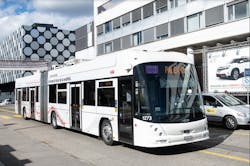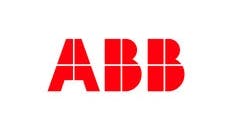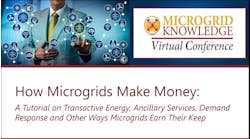A collaboration between ABB and China electric bus (e-bus) manufacturer King Long Motor Group holds the promise of a flash-charging system for e-buses that opens the door to electric vehicle-to-grid and development of urban microgrids.
ABB and King Long are in the midst of developing a pilot project in China. King Long is designing and assembling the e-bus, while ABB is providing its TOSA flash-charging system. That consists of a wayside feeding station, an energy transfer system and an on-board battery charger.
A joint ABB-King Long development team is at work in Beijing and Xiamen developing the demonstration version of the e-bus with the aim of having it running in the first half of 2020, said Andre Burdet, vice president for grid integration product management and Marketing for ABB Power Grids.
“Regarding microgrids, flash-charging TOSA, thanks to its modular design, has the option to host batteries on the charger side, enabling energy storage and load management in densely populated areas, where the charger would act as an energy interface between the local grid and the public transportation network. Such an application has not been tested yet in real commercial projects but it’s technically feasible,” Burdet said in an interview with Microgrid Knowledge.
Cuts costs and carbon
The fastest EV chargers being installed in major markets around the world today — California, Shanghai and in Germany, for instance — reportedly can deliver electric cars 20 miles of driving range in one minute.
In comparision, ABB’s TOSA flash-charging system is able to charge an e-bus in just seconds, while passengers get on and off a bus, or even while it’s en route, according to ABB. That avoids having to take e-buses out of service every few hours for recharging or having a replacement on hand, which in turn reduces the size of an e-bus fleet and offers potential cost savings. In addition, the fast-charging system doesn’t need to connect to any power lines, which also saves money and makes for easier deployment and better operating efficiency.
Various countries around the world, including China, have set national EV and electrification of transportation goals in the past couple of years. That’s led market analysts to boost sales forecasts. BloombergNEF expects EVs will account for more than half of all new car sales come 2040, for instance. Battery life and driving ranges will increase in parallel, while charging times will decrease, according to the market research provider.
China is the world’s largest market for e-buses, and King Long Motor Group is one of the largest bus and coach manufacturers in China and the world, according to ABB.
An ABB TOSA fast-charging e-bus system is up and running in Geneva, Switzerland, where the system has delivered more than 310,000 miles of charging, avoiding more than 1,000 tons of carbon dioxide emissions. Looking ahead, a 20 e-bus TOSA system is slated to be deployed in Nantes, France this month.
ABB’s presence is well established in China, as well, Burdet pointed out. ABB and King Long Motor Group launched the TOSA e-bus flash-charging development partnership in early 2018, he said.
The TOSA flash-charging system
The TOSA e-bus charging system consists of a connection with medium- or low-voltage power lines with a dedicated transformer and a voltage source converter for energy transfers to e-buses. A battery pack can be installed in the charger, opening up the possibility of storing energy at any time either from e-bus batteries or from the grid during periods of low demand and then charging e-bus batteries during peak-demand periods for peak shaving, Burdet explained.
An Energy Transfer System (ETS) is another key component of the TOSA flash-charging system. The ETS “is an intelligent pantograph that makes the physical connection between the bus and the wayside charger,” Burdet said. The ETS has a self-positioning capability enabling the bus to stop within a relatively large area, as opposed to having a strictly fixed stop.
An on-board converter to charge e-bus batteries is a third core element of the system. “As opposed to other types of charging technology, flash-charging TOSA enables a permanent dialogue between the converter and the battery, avoiding lengthy synchronization and thus allowing ultra-fast charging,” Burdet said.
The TOSA system typically can start to transfer more than 600 kW of electrical power in less than one second after the ETS makes a mechanical connection between the charger and the bus, according to Burdet. That, he added, “is a pioneering innovation because any other charging technology requires at least 30 to 40 seconds to start charging when the mechanical connection is made.”
China already has the largest installed base of operating e-buses in the world
e-buses flash-charge at a standstill or en route
It also means that the flash-charging system can charge e-buses en route and not only at bus stops or terminals. As a result, TOSA technology “allows much more flexibility to design the e-bus network,” Burdet said. For example, the technology minimizes issues around where to place the chargers to minimize battery size, bus fleet requirements and risks associated with unexpected traffic events.
Furthermore, the economic returns for TOSA look promising as compared to the current generation of charging technology, particularly when it comes to mass transportation in large cities, Burdet explained.
Burdet noted that China has a substantial number of large cities that require zero-emission mass transportation networks for sustainable socioeconomic development of their urban areas. So it offers a strong testing ground for the technology.
China already has the largest installed base of operating e-buses in the world, leading the way in a zero-emissions public transportation market, Burdet said. However, “smarter solutions are now being required in order to cope with an increased complexity and duty of electric bus networks being implemented. That is why King Long and ABB decided to co-develop a pilot bus to demonstrate to potential customers the benefits of this state-of-the art solution in place.”
Track news about electrification and microgrids. Subscribe to the free Microgrid Knowledge newsletter.








